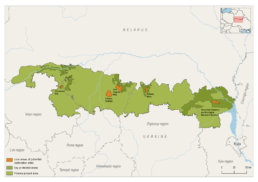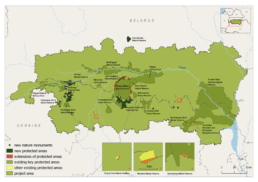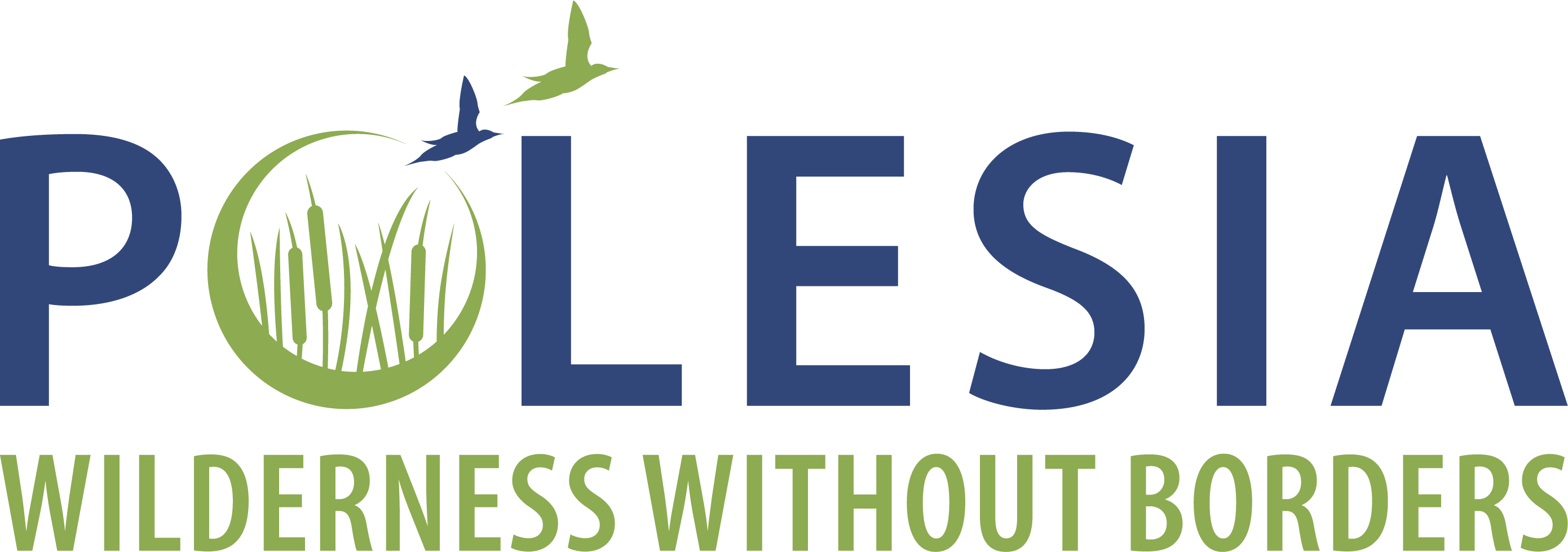The year 2023: conservation wins and new plans for Polesia’s wilderness
2023 was probably one of the most challenging years for nature conservation in Polesia. The ongoing war has forced us to put many activities on hold and revise our plans, and many natural areas in the project region are simply inaccessible. And yet, looking back, we see that our efforts are not in vain - they are bearing fruit, albeit sometimes only after a while. We are learning more about Polesia's nature, taking steps to better protect it, and have big plans for the new year!
Wetland restoration in Ukraine: getting closer to becoming a reality!
The year 2023 started with really good news: we started preparation for restoration of several disturbed wetlands in the Ukrainian part of Polesia.
Though Ukraine is still at war, we, jointly with our partners, organised a meeting on the ground this year with a series of stakeholder discussions and field visits. Wetland restoration is now high on the agenda in Ukraine, with more and more people recognising the importance of ‘healthy’ and fully functioning wetlands. Conservationists point to their major impact on climate change mitigation and biodiversity conservation, while local communities witness the consequences of wetland drainage, which was widespread in Ukraine in the 20th century: lack of drinking water, land degradation, increasing frequency of droughts and growing threat of wildfires. During the war, many people recall another role of wetlands not only once proven in the course of history: barely passable mires serve as a natural defence line and a barrier against possible military invasion.
Seizing the opportunity, experts from the Michael Succow Foundation assessed the feasibility of restoring a number of wetlands and shortlisted five sites in Ukrainian Polesia for restoration.

The sites are located in different administrative regions of the country, and it is expected that our work will result not only in the restoration of 20,000 hectares of degraded wetlands, but also in the creation of groups of experts in each region, equipped with restoration knowledge and experience, who will be able to expand this process in the future.
Better protection for areas, biotopes and species
While we are focusing on landscape restoration in Ukraine, our efforts on putting new wilderness areas under protection in Belarus undertaken in 2020-2021 bore fruit. Here, we still find vast areas of well-preserved and functioning natural landscapes that are of high conservation value, but they still don’t enjoy full-scale protection and are mainly threatened by anthropogenic factors. The first thing they need is a legal protection status that will ensure the implementation of systematic and science-based conservation measures.
In 2023, a new nature reserve, Lva Floodplain, was designated in the Belarusian part of Polesia. This is the result of several years of the systematic work: initially, the designation was initially lobbied by our project in 2020-2021. The total area of the nature reserve amounts to 2,400 hectares. It is a part of the national ecological network, a prospective Ramsar site and a potential UNESCO biosphere reserve. The new nature reserve occupies a part of a vast forest and mire complex in the Lva River floodplain, which is an important ecological corridor and a key area for rare bird species as the Greater Spotted Eagle (Clanga clanga) and the Hen Harrier (Circus cyaneus). In total, field surveys proved the presence of 588 plant species and 181 species of terrestrial vertebrates, including 27 bird species and 8 mammal species listed in the Red Data Book of Belarus, in the Lva Floodplain. Importantly, the new protected area borders the Almany Mires Nature Reserve, which enhances the ecological connectivity.

Smaller natural areas that need protection can be represented by separate habitat sites of rare species or by valuable biotopes that, being once destroyed, can never be fully restored back to their natural state. This year, 5,000 hectares of rare and typical biotopes as well as habitat sites of rare species were taken under legal protection in Belarusian Polesia. 13 additional nesting sites of the globally vulnerable Greater Spotted Eagle (Clanga clanga) are now protected. The field surveys were carried out, areas identified as being in need of protection and the relevant applications submitted to the state bodies back in 2021 as part of our project. The documents were finally adopted in 2023 by the relevant authorities.
Science: Advocating for more protected areas and wetland restoration
Research helps us to better understand the processes taking place in the Polesian landscape, to identify threats to its nature and to find the most appropriate approaches and solutions. In 2023, a number of papers were published based on research and field surveys carried out in Polesia in previous years.

Landscape fires are a pressing issue for Polesia: vast drained areas became prone to fires, the most dangerous of which occur in peatlands. Fires threaten the safety, health and lives of people and do damage to the economy. A lot of resources are spent for fighting fires during hot and dry periods. The problem is likely to get worse as the climate changes. The authors of a recent study from our partner organisation the British Trust for Ornithology have mapped and analysed large fires that occurred in Polesia over a 19-year period. For the first time, researchers have determined the patterns, environmental and human drivers of fires in Polesia’s ecosystems. Unfortunately, fires disproportionally affect Polesia’s protected, internationally important peatlands and floodplain meadows, and the most extreme fires threaten primeval deciduous forests. The authors of the study are convinced that there is a cost-effective, nature-based solution to the problem – restoration of the drained wetlands that could set natural barriers to large devastating fires.
Using widely available satellite data and a cloud-based software, the authors of the study elaborated a replicable methodology that can be applied anywhere in the world, positively impacting landscape restoration and effectiveness of fire protection measures.

Another recent publication focuses on the Polesian population of the Grey Wolf (Canis lupus). The population is still understudied, although it is of great conservation importance as a link between large populations of the species in Poland and the Baltic States on the one hand, and the Russian Federation on the other. The authors analysed the impact of anthropogenic factors on the habitat suitability of wolves in Polesia. Correlating the confirmed facts of the presence of the species with the characteristics of the landscape, they concluded that wolves avoid areas with a prevalence of cropland, a high index of artificial light at night and a high density of roads. This means that the anthropogenic impact on the distribution of the grey wolf is high. The authors of the study conclude: Although 26% of Polesia’s territory is suitable for the species, not all of these areas are occupied by wolves. Some high quality areas are isolated from each other and it is very important to prevent their further fragmentation. On the contrary, the creation of new protected areas is important to ensure stable connectivity between core protected areas for wolf conservation.

The Polesian population of the Eurasian Lynx (Lynx lynx), like that of the Grey Wolf, is still understudied. The lynx is a key carnivore species for the whole of Europe and has a major ecological impact on ecosystems. Lynx populations in Belarus and Ukraine are linked to populations in other parts of Central Europe, so understanding their status is important for developing Europe-wide measures to protect the species.
The unprecedented camera trapping survey carried out in 2020-2021 in the protected areas of Polesia, including the Chornobyl Exclusion Zone in Ukraine and the nature reserves of Pripyat-Polesia (central part) in Belarus, became the basis for systematic, science-based research on the species in the region. The work resulted in the most valuable and comparable lynx density estimates for Ukraine and Belarus to date. The authors of the study point out that the species is threatened by poaching and habitat fragmentation caused by anthropogenic factors. Therefore, protected areas play a significant role as refugia for lynx. However, more research is needed to understand other aspects of the species’ status, such as the genetic diversity of the population or the full range of ecological and anthropogenic factors affecting the species in the region.

Everything we have achieved this year is, on the one hand, a continuation of the great systematic work started several years ago. On the other hand, it paves the way for a deeper understanding of the nature of Polesia and makes practical steps for its conservation and restoration more reasonable and targeted. We go into the new year not carelessly, but with faith in our work for the sake of the Polesia’s nature and people.
The project “Polesia – Wilderness Without Borders” is part of the Endangered Landscapes & Seascapes Programme and is funded by Arcadia. The project is coordinated by Frankfurt Zoological Society (FZS).
This post is also available in UKR.









